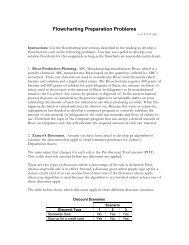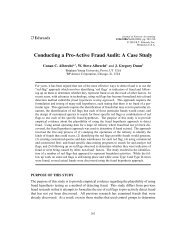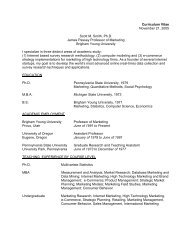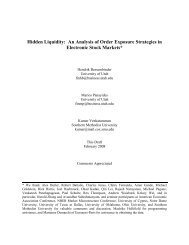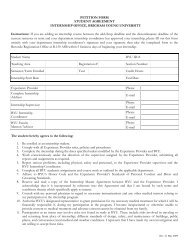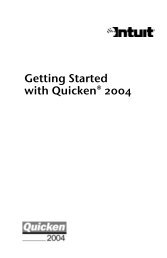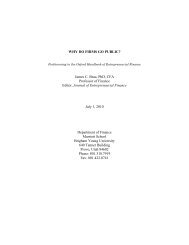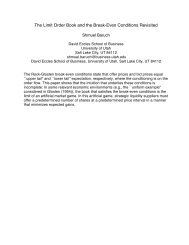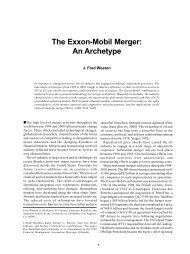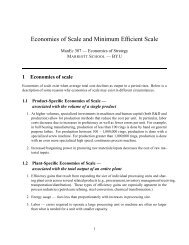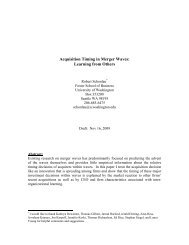Albrecht 19.pdf - Marriott School
Albrecht 19.pdf - Marriott School
Albrecht 19.pdf - Marriott School
Create successful ePaper yourself
Turn your PDF publications into a flip-book with our unique Google optimized e-Paper software.
76154_23_ch19_p942-1006.qxd 3/1/07 3:35 PM Page 964<br />
964 Part 6 Control in a Management Accounting System<br />
R E M E M B E R T H I S . . .<br />
• Profit centers and their managers are usually evaluated on both costs and<br />
revenues.<br />
• The most common profit center measurement tool is the segment margin statement.<br />
This statement identifies both direct and indirect costs and charges only<br />
the direct costs to segments.<br />
• Costs in profit centers are analyzed and managed the same way they are in cost<br />
centers—using standard costing. But because profit center managers are also<br />
held responsible for revenues, actual and expected revenues are used to compute<br />
sales price variances and sales volume variances.<br />
• The formula for the sales price variance is:<br />
(Actual price Standard price) Actual quantity sold.<br />
• The formula for the sales volume variance is:<br />
(Actual quantity sold Expected quantity sold) Standard price.<br />
Use ROI and residual<br />
income analysis to<br />
explain how<br />
performance is<br />
controlled in<br />
investment centers.<br />
return on<br />
investment (ROI)<br />
A measure of operating<br />
performance and efficiency<br />
in utilizing assets;<br />
computed in its simplest<br />
form by dividing operating<br />
profit by average total<br />
assets.<br />
4<br />
Evaluating Performance<br />
in Investment Centers<br />
An investment center was defined earlier as an organizational unit in which a manager<br />
has responsibility for costs, revenues, and assets. Overall, companies are considered<br />
to be investment centers, as are some independent segments of<br />
decentralized companies. For example, the Acme Computer and Edison Automobile<br />
subsidiaries of IMC (see Exhibit 1) would probably both be investment centers.<br />
Officers of such segments are responsible for acquiring and managing the assets required<br />
to manufacture and market their products, as well as for managing the revenues<br />
and costs related to those products. The assets include inventory, accounts<br />
receivable, and long-term operating assets such as equipment and delivery trucks. On the<br />
other hand, Edison’s Japan Operations could be considered a profit center if all asset management<br />
decisions are handled by Far East operations. (If Japan Operations handles its own<br />
asset management decisions, then it would be an investment center.) Further, the<br />
Manufacturing center for Japan Operations is likely a cost center since it doesn’t control sales.<br />
The bottom line is that when a segment essentially operates as a separate company<br />
with responsibility for all of its assets, then it is considered to be an investment center.<br />
There are several methods of evaluating the performance of an investment center. Two<br />
of the most common methods used are the rate of return on invested assets and the residual<br />
income.<br />
Return on Investment (ROI)<br />
You may recall that we introduced management accounting in Chapter 15 by describing<br />
how the management team at DuPont used return on investment<br />
(ROI) (sometimes called return on total assets) to manage their company to success<br />
in the early 1900s. ROI is a measure of how much has been earned on the<br />
assets of a company; it is equal to operating profit divided by total assets. For example,<br />
if a company earned $1,000 on $10,000 of assets 5 for one year, its ROI<br />
would be $1,000 $10,000, or 10%.<br />
5 In this chapter, we will use the term ROI instead of return on total assets because it is more commonly used in management<br />
decision making. In this text we will use average total assets instead of ending total assets to calculate ROI (although<br />
in actual practice, management teams in some organizations may choose to use ending total assets). Average total assets is<br />
generally computed by adding the assets balances at the beginning and end of the year, and then dividing the sum in half.



